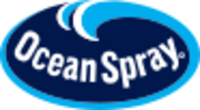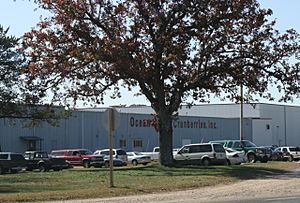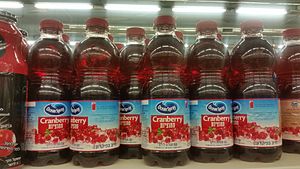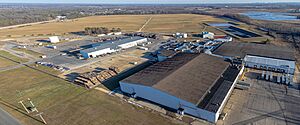Ocean Spray (cooperative) facts for kids

Logo as of 2024
|
|
| Agricultural cooperative | |
| Founded | 1930 in Hanson, Massachusetts |
| Founders | Elizabeth Lee, John Makepeace, and Marcus Urann |
| Headquarters |
Lakeville-Middleborough, Massachusetts
,
United States
|
|
Key people
|
Tom Hayes, President and CEO |
| Products | Cranberries, grapefruit |
Ocean Spray Cranberries, Inc. is an American company that works with cranberry growers. It is based in Plymouth County, Massachusetts. Over 700 growers are part of this group, from places like Massachusetts, Wisconsin, and Canada.
Ocean Spray has about 2,000 employees. They are known for making many cranberry products. These include cranberry sauce, fruit juices, and dried cranberries (called Craisins). They produce most of the cranberries in North America.
The company has created many new things. They made the first mixed juice drink and the first juice boxes. Their cranberry juice has even won awards for its great taste.
Contents
How Ocean Spray Started
Ocean Spray began in 1930. It was first called Cranberry Canners, Inc. Three cranberry growers started it to sell more cranberries. These founders were Marcus L. Urann, Elizabeth F. Lee, and John C. Makepeace. They set up their group in Hanson, Massachusetts.
Being a cooperative helped them set fair prices for all members. At first, they mainly sold cranberry jelly and juice for holidays like Thanksgiving. Marcus Urann was important because he helped can and bottle cranberry products.
Cranberry Juice Cocktail was introduced in 1933. The jellied cranberry sauce in a log shape became available in 1941. More growers joined from other states. In 1946, the group became the National Cranberry Association. In 1957, they changed their name to Ocean Spray. They got the name and logo from a fish company.
Growing and Changing the Business
In 1959, there was a health concern about a product used on cranberries. This caused the company to lose a lot of money. To avoid future problems, Ocean Spray decided to also focus on marketing. They created a reserve fund for cranberries.
In 1963, a person named Edward Gelsthorpe helped create Cranapple juice. This new product made cranberries much more popular all year round. Ocean Spray soon made Cran-Apple and Cran-Grape juices. They also started promoting cranberry juice as a drink mixer. By 1966, drink recipes were printed on every bottle of Cranberry Juice Cocktail.
Expanding to New Products and Places
In 1976, Ocean Spray welcomed grapefruit growers from Florida. Within two years, their grapefruit juice was very popular. In September 1976, the main office moved to Plymouth, Massachusetts. A museum called Cranberry World opened there the next year.
By 1978, Ocean Spray had 705 growers. Selling fresh cranberries was only a small part of their business. Half of their sales came from juice. They also partnered with prune growers in California. By 1986, their sales reached $640 million.
In 1988, Ocean Spray faced issues regarding water quality. Their processing plant in Middleboro, Massachusetts, had caused pollution. Ocean Spray agreed to pay a fine and fix the problem.
In 1989, Ocean Spray introduced Craisins, which are sweetened dried cranberries. The company's main office also moved to the border of Lakeville and Middleborough.
Challenges and New Ideas
By 1991, Ocean Spray had operations in many states and Canada. They worked with PepsiCo for a few years starting in 1992. This was to compete with other popular drinks. The partnership ended in 1995, but they kept a distribution deal.
In 1993, some growers left to start a rival company called Northland Cranberries. In 1994, a study showed that cranberry juice was good for health. This made more people want cranberries. Ocean Spray increased the land they used for growing cranberries. However, by 1999, there were too many cranberries.
In 1997, Ocean Spray bought most of a juice company called Nantucket Nectars. Between 1998 and 1999, their share of the market went down. They reduced staff at their main office. In 2000, there were so many cranberries that the US government asked growers to produce less.

Some growers wanted the company to be sold, but the idea was not approved. The chief executive retired, and the board was changed. In 2000, some unhappy growers sued Ocean Spray to try and force a sale. In January 2001, growers voted against selling the company. That year, cranberry prices were very low. The US Department of Agriculture asked farmers to cut production even more.
To create more demand, Ocean Spray introduced white cranberry juice in 2002. They also sold Nantucket Nectars to focus on their main juice products. In November, the co-op's chief executive left. Northland Cranberries also filed a lawsuit against Ocean Spray.
In 2003, Northland Cranberries offered to buy Ocean Spray, but the offer was rejected. In March, the co-op voted to change its board of directors. This new board would be more helpful to smaller growers.
In May 2004, PepsiCo offered to buy half of Ocean Spray. However, members voted against selling the beverage business. In July, some growers left the cooperative.
In September 2004, Ocean Spray agreed to buy Northland Cranberry's processing facilities. This ended Northland's lawsuit. The purchase included a juice production plant in Wisconsin Rapids, Wisconsin.
Modern Innovations and Challenges
In June 2006, Ocean Spray agreed to stop supporting animal tests. These tests were done to see if cranberry juice helped with stomach issues. In July 2006, the cooperative signed a long-term deal with Pepsi to distribute single-serve juices.

Ocean Spray finished expanding its Wisconsin Rapids processing plant in September 2008. This made it the world's largest cranberry processing facility. The plant now produces Craisins and juice concentrates.
By the end of 2008, Ocean Spray had grown in other countries. Australia, Britain, Canada, and Germany were very successful markets. Sales in Japan also grew.
From 2003, Ocean Spray increased Craisins production. But soon, there was too much cranberry juice concentrate. To fix this, the company started selling the extra concentrate at auctions in 2009. These low prices caused some independent growers to file a lawsuit. They claimed the company was unfairly setting prices.
In the 2000s, Ocean Spray set up cranberry bog displays in Las Vegas and New York City. In 2010, they partnered with Disney for a similar exhibit at Epcot. In 2014, Ocean Spray worked with PepsiCo International to make and sell cranberry drinks in Latin America.
In 2011, Ocean Spray announced it would close its bottling plant in Bordentown, New Jersey. They opened a new, larger facility in Pennsylvania's Lehigh Valley in 2014. This new plant handles about 40% of the company's North American juice products.
Around 2012, there was another surplus of cranberries. To find more buyers, Ocean Spray started selling in China. However, in 2018, trade disagreements between the United States and China affected sales of dried cranberries.
In 2019, Ocean Spray started Lighthouse Innovation Incubator. This group develops new health and wellness products. They have created herbal drinks, sparkling water with CBD, gummy supplements, and water enhancers for dogs.
In January 2020, Ocean Spray settled a legal issue. Some people claimed their products were misleadingly advertised as not having artificial flavors. The company agreed to pay money to those who made claims.
In February 2020, Ocean Spray changed its leadership due to a policy violation. In April, the company's cranberries were confirmed to be 100% sustainable.
Images for kids





